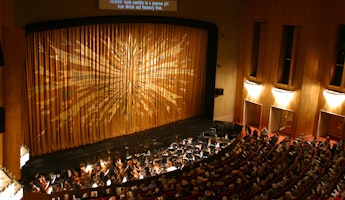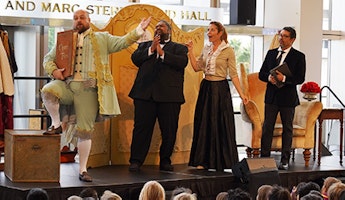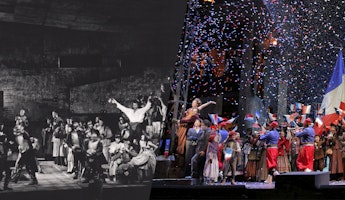Blog
November 2, 2021
Inside "Alcina"
ABOUT THE COMPOSER
The war for supremacy in the world of Italian-opera production in early-18th-century London was as vicious as anything that happened on the battlefields or in the courts of Europe in that era. From 1720 on, when he directed his first operatic season at the Royal Academy of Music, Handel was the reigning monarch of this world, but there were many pretenders to the throne. For the better part of a decade, Handel had to compete with Italian composer Giovanna Bononcini, not only as to which was the better composer, but also which could engage the most celebrated Italian singers and showcase them in the most lavish productions.
In 1727, Handel suffered a blow with the death of King George I, who had backed Handel with his patronage and financial largesse. A bigger one came the next year: the triumphant London production of John Gay’s The Beggar’s Opera, an English-language comic adventure with music inspired by popular ballads. Suddenly, the imported form of Italian opera seria seemed an artificial and elitist art form to the British public, and before 1728, both Handel’s and Bononcini’s companies sank in a sea of debt.
But the enterprising Handel was not finished yet, and neither was Italian opera in London. By the 1730s, now supported by the Princess Royal, he was back in business, but this time facing a new rival: the Opera of the Nobility led by Nicola Porpora, an able composer and, moreover, Italy’s most famous vocal pedagogue whose pupils included the legendary castrato Farinelli. Not content with having Farinelli on his roster, Porpora lured away many of Handel’s vocal stars, including the castrato contralto Senesino, with fatter contracts. Handel’s unlikely savior was the impresario John Rich, who, ironically, had been the producer of The Beggar’s Opera; flush with profits from that show, he built a handsome new opera house at Covent Garden on the site of the present Royal Opera House and invited Handel to go into partnership with him there.
On April 16, 1735, Handel introduced one of his greatest masterpieces, the exquisite fantasy opera Alcina, replete with an extraordinary title character, spectacular scenic effects, and a series of the most gorgeous and dramatically expressive arias he had ever created. It was one of the major successes of Handel’s career, earning 18 performances in its first season and even winning the support of his erstwhile opponent, the former Prince of Wales, now George II.
Magnificent as it was, Alcina could not ultimately save the overheated, money-hemorrhaging field of Italian opera in England. By 1737, the ferocious rivalry between Handel and Porpora—as well as changing tastes—destroyed both their companies. Finally, Handel turned his back for good on operatic composition and moved on to the oratorio genre.
Magnificent as it was, Alcina could not ultimately save the overheated, money-hemorrhaging field of Italian opera in England. By 1737, the ferocious rivalry between Handel and Porpora—as well as changing tastes—destroyed both their companies. Finally, Handel turned his back for good on operatic composition and moved on to the oratorio genre.
AN INNOVATIVE OPERA
Challenged by Rich to make his operas more appealing to jaded London audiences, Handel introduced a number of new elements in Alcina. Though it hardly matches the role it plays in his oratorios, he placed more emphasis on the chorus, which introduces us to Alcina’s court with “Questo è il cielo di contenti” (“This is the heaven of delight”)—ravishing music that portrays Alcina’s realm as a golden paradise for the senses. The chorus also voices the wonder of the final transformation scene as Alcina’s beasts are transformed back into people (“Dall’orror di notte cieca”). The ballet also plays a prominent part in Alcina’s staging. Rich imported Marie Sallé’s troupe from France, and Handel gave it some delicious dance music that begins with the opening curtain. The opera closes with an infectious, French-sounding tambourine dance, with its characteristic beating drum for both the dancers and chorus.
Scenic display had always been an important feature in Italian opera for the London stage, but Handel considerably raised the ante with Alcina. What first appears as a barren desert as the curtain rises is soon transformed into the enchantress’s gorgeous court. And the final scene is the most spectacular of all, as Ruggiero’s shattering of the magic urn causes Alcina’s kingdom to disintegrate and the wild beasts in their cages to regain their human shapes.
Deprived of most of his Italian stars, Handel turned to homegrown singers to fill many of the leading roles. Although the three major parts—Alcina Ruggiero and Bradamante—were entrusted to Italians, English singers played Morgana and Oronte. Tenor John Beard, who would eventually become the manager of Covent Garden, took the role of Oronte, Alcina’s jealous general; his arias, especially Act I’s cynical “Semplicetto!” with its nastily nagging bass line warning Ruggiero never to trust a woman’s love, add an engaging touch of comedy to the score. Cecilia Young sang Morgana, and the arias Handel composed for her light soprano are among the opera’s most attractive, especially Act I’s “Tornami a vagheggiar,” with its infectious melody and sparkling fanfare-like coloratura, and Act II’s “Ama, sospira” with its brilliant violin obbligato part.
A CLOSER LISTEN
Handel lavished his finest music on his three leads. The brave, devoted Bradamante is given the opera’s most demanding coloratura test in her Act II “Vorrei vendicarmi” (“I would be avenged”), expressing her frustration and fury that Ruggiero persists in disbelieving her identity. This is a classic Handelian rage aria, driven by a frenzied violin part. Throughout Alcina, however, the composer frequently brings high contrast to the B section of the da capo aria form, this time with much slower, poignant music in the minor mode that reveals the suffering that lies behind her anger.
In Act I, Ruggiero is also given a brilliant virtuoso showpiece in “Bramo di trionfar” (“I long to triumph”), whose challenging coloratura melismas suited the vocal strengths of its originator, castrato star GIovanni Carestini. Handel actually struck this aria from his original score, perhaps because it seemed to convey the wrong mood for a character who at this point in the story is hardly heroic as he continues to languish in his infatuation with Alcina. More suited to Ruggiero’s character as lover is Act II’s "Mi lusinga il dolce affetto” (“I am filled with sweet affection”), one of the opera’s most ravishingly beautiful lyrical moments in which highly expressive slow melismas express his growing realization of this betrayal of Bradamante.
Also from Act II comes the opera’s most famous aria, “Verdi prati” (“Verdant meadows”), which Carestini initially refused to sing because of its lack of virtuosity. Handel reacted in fury, ordering him to sing it or forfeit his fee. Not a full-fledged da capo aria, it unfurls unadorned phrases of legato loveliness as Ruggiero muses that the beauties of Alcina’s pastoral paradise will soon be destroyed.
The glories of the score, however, go to Handel’s alluring heroine/villainess, Alcina herself. Over the course of six magnificent arias, the composer charts the many facets of her personality and the erosion of her magical powers. When we first meet her in Act I’s regal, yet feminine, “Di, cor mio” (“Tell them, dear heart”), she exhibits no hint of her malevolent side, but appears in this enraptured music to be simply a woman in love with Ruggiero. But “Si, son quella” (“I am still true”) later in the act shows her manipulativeness as she tries to lure a restless Ruggiero back into her embrace with a mournful cello solo as her accomplice.
Genuine sorrow appears in Alcina’s “Ah! mio cor” in Act II after Oronte brings her the news that Ruggiero seeks to escape from her. Built on an orchestral ritornello that represents the painful beating of a breaking hear, it opens with a great sigh of anguish, which becomes still more poignant at the da capo return. The spectacular B section, by contrast, is a miniature rage aria showing she is still a dangerous opponent.
If one had to select the greatest of Alcina’s numbers, it would surely be the scena of accompanied recitative—”Ah! Ruggiero crudel”—and aria—”Ombre pallide” (“Pale shades”)—that closes Act II. Handel saved the more arioso-like accompanied recitative form for very special moments, and “Ah! Ruggiero” is one of his most remarkable, dramatizing the undoing of a woman of great stature and power. In this scene of tragic grandeur, Alcina is reduced to pleading with her supernatural powers to aid her, amid impotent cries of “perchè” (“why”).
“Ma quando tornerai” (“But when you return”), Alcina’s response to Ruggiero’s farewell in Act III, is a stunning example of the polychromatic da capo aria of mixed emotions. The jagged, leaping lines of the fast A section express her desire to punish Ruggiero for his treachery; in the plaintive B section, the tempo slows as she makes a final plea for his love in grand descending phrases in the minor mode. Her final aria, “Mi restano le lagrime” (“Only tears remain to me”), is an achingly beautiful melody in the rarely chosen key of F-sharp minor and a gently rocking siciliano rhythm. Alcina longs to escape her pain by transforming herself into some inanimate object, as she has done with so many of her hapless victims. In this sublime music, she is no utterly powerless: a supernatural being changed by love into a mortal woman.—Janet E. Bedell
© 2021 Carnegie Hall. Reprinted with permission.








/03-cosi/_dsc0996_pr.jpg?format=auto&fit=crop&w=345&h=200&auto=format)















